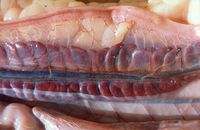Difference between revisions of "Snake Urinary System"
Fiorecastro (talk | contribs) |
|||
| (3 intermediate revisions by 2 users not shown) | |||
| Line 1: | Line 1: | ||
| − | + | ||
[[Image:Burmese_python_kidneys2.jpg|200px|thumb|right|'''Kidneys of a [[Burmese Python|Burmese python]]''' (Copyright © RVC)]] | [[Image:Burmese_python_kidneys2.jpg|200px|thumb|right|'''Kidneys of a [[Burmese Python|Burmese python]]''' (Copyright © RVC)]] | ||
The urinary system of snakes consists of paired lobulated kidneys and ureters that empty into the dorsal urodeum. | The urinary system of snakes consists of paired lobulated kidneys and ureters that empty into the dorsal urodeum. | ||
| Line 5: | Line 5: | ||
==Kidney== | ==Kidney== | ||
Paired kidneys are located in the dorsal caudal coelomic cavity with the right kidney cranial to the left. They are elongated, lobulated and somewhat triangular in cross section. All reptiles have metanephric kidneys that are simpler than the mammalian counterpart. There are decreased number of glomeruli (some species are aglomerular) and there is no loop of Henle. They may have one or more renal arteries and in some species, there is a separate branch of the ureter draining each lobule. There may be a sexual segment in the caudal kidney that follows up the distal part of each tubule and empties into a collecting duct. Since no urinary bladder is present, urine is not stored and ureters empty directy into the [[Cloaca|cloaca]]. | Paired kidneys are located in the dorsal caudal coelomic cavity with the right kidney cranial to the left. They are elongated, lobulated and somewhat triangular in cross section. All reptiles have metanephric kidneys that are simpler than the mammalian counterpart. There are decreased number of glomeruli (some species are aglomerular) and there is no loop of Henle. They may have one or more renal arteries and in some species, there is a separate branch of the ureter draining each lobule. There may be a sexual segment in the caudal kidney that follows up the distal part of each tubule and empties into a collecting duct. Since no urinary bladder is present, urine is not stored and ureters empty directy into the [[Cloaca|cloaca]]. | ||
| + | |||
| + | * '''For information on renal diseases, see''' [[Lizard and Snake Renal Disease|snake renal disease]]. | ||
==Uric acid== | ==Uric acid== | ||
| Line 11: | Line 13: | ||
==Ureters and Cloaca== | ==Ureters and Cloaca== | ||
Snakes have no bladder. The ureter enters the urodeum at a urogenital papilla and urine refluxes into the [[Snake Digestive System|colon]] for fluid conservation. | Snakes have no bladder. The ureter enters the urodeum at a urogenital papilla and urine refluxes into the [[Snake Digestive System|colon]] for fluid conservation. | ||
| − | + | ||
| − | + | {{Learning | |
| − | + | |full text = [http://www.cabi.org/cabdirect/FullTextPDF/2009/20093069451.pdf ''' Reptile and amphibian renal systems.''' Wyneken, J.; Mader, D.; Association of Reptilian and Amphibian Veterinarians, Chester Heights, USA, Proceedings of the Association of Reptilian and Amphibian Veterinarians, 14th Annual Conference, New Orleans, Louisiana, USA, 14-18 April, 2007, 2007, pp 62-68, 13 ref.] | |
| + | }} | ||
| + | |||
==Reference== | ==Reference== | ||
Mader, D.R. (2005). Reptile Medicine and Surgery. Saunders. pp. 49. ISBN 072169327X | Mader, D.R. (2005). Reptile Medicine and Surgery. Saunders. pp. 49. ISBN 072169327X | ||
| + | |||
| + | {{review}} | ||
| + | |||
| + | ==Webinars== | ||
| + | <rss max="10" highlight="none">https://www.thewebinarvet.com/urogenital-and-reproduction/webinars/feed</rss> | ||
| + | |||
| + | [[Category:Snake_Anatomy]] | ||
Latest revision as of 16:56, 4 January 2023

The urinary system of snakes consists of paired lobulated kidneys and ureters that empty into the dorsal urodeum.
Kidney
Paired kidneys are located in the dorsal caudal coelomic cavity with the right kidney cranial to the left. They are elongated, lobulated and somewhat triangular in cross section. All reptiles have metanephric kidneys that are simpler than the mammalian counterpart. There are decreased number of glomeruli (some species are aglomerular) and there is no loop of Henle. They may have one or more renal arteries and in some species, there is a separate branch of the ureter draining each lobule. There may be a sexual segment in the caudal kidney that follows up the distal part of each tubule and empties into a collecting duct. Since no urinary bladder is present, urine is not stored and ureters empty directy into the cloaca.
- For information on renal diseases, see snake renal disease.
Uric acid
Uric acid is the main form of nitrogenous waste with lesser amounts of ammonia and urea depending on the species, the natural environment and degree of water conservation required. Uric acid is excreted by tubular secretion rather than urea by glomerular filtration
Ureters and Cloaca
Snakes have no bladder. The ureter enters the urodeum at a urogenital papilla and urine refluxes into the colon for fluid conservation.
| Snake Urinary System Learning Resources | |
|---|---|
 Full text articles available from CAB Abstract (CABI log in required) |
Reptile and amphibian renal systems. Wyneken, J.; Mader, D.; Association of Reptilian and Amphibian Veterinarians, Chester Heights, USA, Proceedings of the Association of Reptilian and Amphibian Veterinarians, 14th Annual Conference, New Orleans, Louisiana, USA, 14-18 April, 2007, 2007, pp 62-68, 13 ref. |
Reference
Mader, D.R. (2005). Reptile Medicine and Surgery. Saunders. pp. 49. ISBN 072169327X
| This article has been peer reviewed but is awaiting expert review. If you would like to help with this, please see more information about expert reviewing. |
Webinars
Failed to load RSS feed from https://www.thewebinarvet.com/urogenital-and-reproduction/webinars/feed: Error parsing XML for RSS